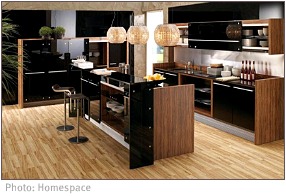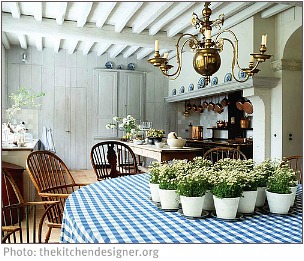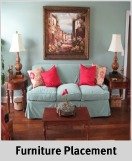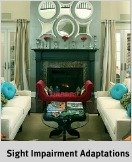|
Interior Home Design Principles
Unity can be achieved by using similar and related effects that link different elements of design together. Remember this principle especially if you are decorating your whole home. You want a cohesive feel in your home, not a series of unrelated rooms. Some easy ways to achieve unity are by using the same theme throughout your home, and by using a monochromatic colour palette. Unity in interior home design - some pictures 
Unity is created in this kitchen by the use of similar coloured wood as both the floor and the unit surrounds. The cabinets are all black and the cabinet door size is repeated often in the kitchen. Notice too the beautiful hanging lights - creating both a sense of rhythm and also a focal point. 
In this unusual country inspired kitchen there is unity in repetition of lines. The lines of the ceiling beams, lines of the wooden wall, the line of the mantel, a row of copper pots and pans, rows of blue plates. The blue tone is also used throughout to unify the space, both in the blue of the plates as well as the table cloth. Unity is also brought about in the repetition of circular shapes. There is the round table with an outer ring of chairs (rounded at the top), there is a circular grouping of pot plants and the openings of the pots are circular as well, the chandelier suggests a wheel shape, the pots and plates are also circular, and the doorway is arched. Exploring other interior home design principles and how they bring about unity
Balance Although the principle of emphasis may seem opposite to that of balance it anchors the room and gives the viewer a starting point from which to understand the decor. It also makes the room more interesting. Emphasis can also bring about a sense of unity by grouping similar items together - the items feel as though they belong together and yet also stand out and attract attention. Repetition of colour, shape or motif not only creates a sense of rhythm it also unifies those elements in your decor. Movement in decorating creates unity by guiding the eye around the room.By using the correct
proportion and scale
|







